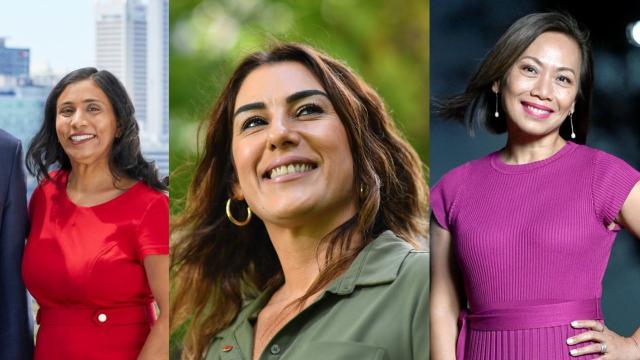The message from Saturday’s election result was clear: Australians want a political reset. And not just about issues such as government integrity and climate change.
While much attention has been directed at the teal wave of independents, another change is taking place to the composition of parliament.
This Australian parliament is shaping to be the most diverse yet in its ethnic and cultural background. Capital Hill is about to see a substantial injection of colour.
A fitting result
Newly elected members Sally Sitou, Michelle Ananda-Rajah, Sam Lim, Zaneta Mascarenhas, Cassandra Fernando and Dai Le will bolster the non-European representation of the House of Representatives.
The Indigenous ranks of parliament are also set to swell, with the additions of Marion Scrymgour and Gordon Reid in the House, and Jacinta Price in the Senate.
In many ways, it is a fitting result to an election that had its share of controversies about representation.
Labor caused consternation when it parachuted former Senator (and ex-NSW Premier) Kristina Keneally into its then safe southwest Sydney electorate of Fowler, cruelling the prospects of local Vietnamese-Australian lawyer Tu Le.
A second captain’s pick from Anthony Albanese, millionaire former political adviser Andrew Charlton, ran in the western Sydney seat of Parramatta, to the chagrin of local aspirants from multicultural backgrounds.
Such picks left many asking, with good reason: if worthy candidates from non-European backgrounds can’t get preselected in multicultural electorates like Fowler and Parramatta, how can we get more diversity into parliament?
It’s a question that lingers, notwithstanding what this election has delivered.
Still a long way to go
If it feels like a surge of diversity will flow through the parliament, it’s only because there was so little to begin with.
While those from a non-European background make up an estimated 21% of the Australian population, they made up just a tiny fraction of the 46th parliament.
The 47th parliament could feature up to 13 parliamentarians with a non-European, non-Indigenous background, along with nine or ten (depending on final results) parliamentarians of Indigenous background.
That may sound like a strong result – it’s certainly an improvement, and better than how many other major institutions in Australian society perform – but we should put it in perspective.
It would still mean just a tiny fraction of the parliament (no more than 10%) having a non-European or Indigenous background – far less than what you’d see if the parliament actually reflected our society accurately. Australia lags significantly behind the US, UK and Canada and New Zealand.
It’s not all about numbers, of course. We can’t judge the calibre of our parliament solely on whether it’s proportionately representative.
Yet when sections of society can’t see themselves within our public institutions, it is a problem. The very legitimacy, and quality, of those institutions can suffer.
A new phase?
For a long time, calls for greater multicultural diversity in politics have been typically greeted with indifference. It wasn’t an urgent problem. Gender diversity was a higher priority. Political parties didn’t feel the pressure from those supposedly excluded from the system.
That now has changed. Labor has been brutally punished for its Fowler move. A swing of more than 16% saw the seat fall to independent (and former Liberal) Dai Le.
Clearly, being from a non-European background isn’t the electoral handicap political parties have sometimes feared.
Something generational is at play. Australia may once have comfortably accepted that newer arrivals were expected to play the role of the grateful supplicant in their “host society”.
But the children and grandchildren of yesterday’s migrants don’t see themselves as guests in their own country. They aren’t happy refugees or cheerful migrants who are content to know their place. They’re taking their lead less from the Anh Dos of the world and more from the AOCs (Democrat politician Alexandria Ocasio-Cortez) of US politics.
Demands about access and equity for non-English speaking background people have been replaced with calls for the equal treatment of “people of colour” and for attention to “intersectionality”.
We could be seeing a new phase in the evolution of Australia’s multicultural project.
While a triumph in many respects, Australian multiculturalism has to date fallen short on several counts. A celebration of cultural diversity has never been accompanied by a sharing of Anglo-Celtic institutional power. Or, for that matter, by a full reckoning with racial inequality and injustice.
That’s why it will be interesting to observe this new parliament. The very presence of this new ethnic and cultural diversity will, in subtle and not so subtle ways, be felt in Canberra and beyond.
Critical mass matters. It is hard, for example, to imagine a more diverse parliament trying to wind back racial hatred laws (as parliament has done on more than one occasion with respect to the Racial Discrimination Act).
Or to imagine a diverse parliament indulging other periodic bouts of race politics (think of the scaremongering over African gangs in Melbourne or the McCarthyist targeting of Chinese-Australians).
All such excesses become much harder when the people debating such matters have skin in the game.
So don’t mistake the wave of multicultural politicians for being a mere symbolic adornment in Canberra – like the political equivalent of having exotic foods and festivals.
It may feel like a subplot for now, but this could end up being just be as significant as the teal revolution. ![]()
Tim Soutphommasane, Acting Director, Sydney Policy Lab & Professor of Practice (Sociology and Political Theory), University of Sydney
This article is republished from The Conversation under a Creative Commons license. Read the original article.

Leave a Reply
You must be logged in to post a comment.